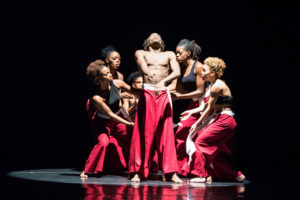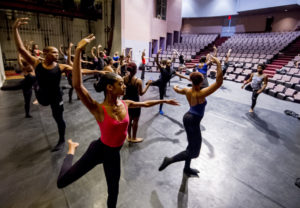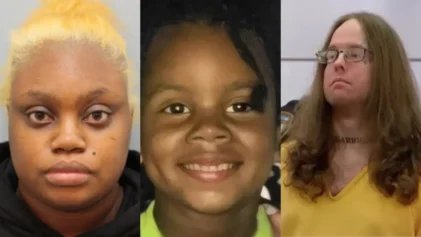
The Dayton Contemporary Dance Company performs “Emergence.” Photo by Scott Robbins
This summer is shaping up to be an exciting one for the Dayton Contemporary Dance Company, as it celebrates its 48th anniversary season at home.
Nestled in the bustling city of Dayton, Ohio, the DCDC was founded in 1968 by Jeraldyne Blunden, an African-American dancer who studied under ballet and modern greats like Martha Graham, George Balanchine and José Límon.
Over the last 48 years, the company has grown to become internationally acclaimed, extending its reach to audiences far beyond Dayton. Blunden’s daughter, Debbie Blunden-Diggs, now serves as artistic director of the world renowned dance troupe.
The vision of the DCDC is to “offer modern contemporary dance of the highest quality to the broadest audience using arts and education as a tool to reach audiences also,” Blunden-Diggs told Atlanta Black Star.
The company’s new season, appropriately titled “Story-Tellers,” will begin July 25 as dancers head back into the studio. Blunden-Diggs said the company has a plethora of exciting events lined up to kick-off the festive celebration.
“For our opening concerts for the 48th season, we’re going to be doing some creation around African-American playwrights,” she explained. “The name of the performance is called Body Talk; myself along with associate artistic director Crystal Michelle will be creating works that sort of mirror or are inspired by African-American playwrights such as James Baldwin or Lorraine Hansberry. So we will create a physical dialogue that speaks to some of their topics.”
According to the DCDC website, other celebratory events include an “Up Close & Personal” experience with the dancers as they learn new choreography; a concert featuring works by New York-based choreographer Ray Mercer; a screening of the film “The Littlest Ange;” and finally a recital put on by the Dayton University Dance Ensemble and DCDC 2, the pre-professional company.
When the company isn’t busy celebrating its anniversary season, the dancers travel across the United States to perform, visiting historically Black colleges and universities along the way. The DCDC began its HBCU Initiative — Young, Gifted, & Black — a few years ago in an effort to expose African-American students to contemporary dance through arts education.

A master class led by the DCDC during their October 2015 residency at Alabama State University. Photo by David Campbell
“It’s efficient,” said Michelle Van Huss, DCDC director of touring and university initiatives. “We’re rooted in the African-American experience, we have the largest inventory of choreography created by choreographers of color; and not only African-American…we have every other walk of life represented in there, too. So we kind of feel it’s a good fit to have the opportunity to take that to HBCUs around the country, especially some HBCUs that are a little bit smaller, maybe a little bit more off the map, to bring the opportunities to kind of watch world-class entertainment right there on their campus.”
Van Huss points out that a number of elementary, middle, high school, and even college-aged students have never had a theater experience before.
“So again…it’s the opportunity to bring it to them, to bring it to their house, to have them come out and see it,” she explained. “To have them talk to the dancers, to discuss ‘why contemporary dance?’ and why the choreographer chose what they chose.”
Each HBCU performance is followed by a talkback session — discourse between the audience and dancers about the works just performed on stage.
But their arts education initiative doesn’t stop there; students can also partake in two to three days of residency activities, discussions, and main stage performances all at a reasonable rate, according to Van Huss. She credits the generous donations from sponsors for making the HBCU Initiative possible; without their funding, the DCDC wouldn’t be able to offer such programs to students.
On last year’s tour, Blunden-Diggs said she had a unique experience at each of the HBCUs. The DCDC travelled to eight universities, including Alabama State University, Cheyney University of Pennsylvania, and Kentucky State University.
“There were a couple of schools that had full-blown dance departments, so they knew the culture,” Blunden-Diggs explained. “And there were some that didn’t offer dance on a level where people take dance classes. So my own philosophy and vision as artistic director is trying to expose them to something that they might not otherwise have a chance to be a part of.”
According to Van Huss, some of the universities utilize the DCDC to visit other schools in their communities or invite students in the area to come watch a performance.
“So it kind of extended beyond just the campus itself,” she said. “We really were able to have classes that were open to the community, to the whole area.”

Alabama State University students participating in a DCDC master class. Photo by David Campbell
Although the initiative is offered to the 100 some-odd HBCUs across America, Van Huss said timing definitely dictated where the DCDC went last year, and where they’ll be going this year. The company is currently in negotiation with two or three other universities, so the dance troupe could visit anywhere from three to five campuses in the upcoming year.
“I think it’s valuable work for the company…but also for the HBCU campuses that are receiving the works,” Blunden-Diggs said. “And so it’s work that I’m very serious about doing.”
The touring program, which runs in accordance with university calendars, was only scheduled for the 15-16 and 16-17 seasons. Van Huss said she’s unsure what the future looks like for the program.
“That’s open for debate at this point,” she stated.
When asked about the importance of African-American dance companies and the role they play in the Black experience, Blunden-Diggs took a moment to respond.
“I have a debate with myself,” she explained, “not because I want to shun the Black dance company caveat, but when we speak of dance companies that are not Black, we don’t call them white dance companies.”
She went on to say that the African-American journey is so rich with emotion and history that “the way we present dance has the ability to transcend boundaries.”
“The way that we tell those stories are quite different than a traditional ballet company or traditional contemporary dance company,” Blunden-Diggs stated.
As it enters its 48th season, the DCDC will continue to offer effective arts education and outreach initiatives around the country as well as in their own backyard.
“…You know little ‘ol Dayton, Ohio in this Midwest region of the United States…it has its own challenges to have a professional dance company, let alone an African-American professional dance company for 48 years,” Blunden-Diggs said. “So we’re really proud of that. We’re gonna have some really, really special things lined up over the next three years.”


